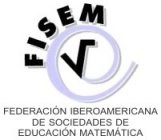Estudantes de psicologia trabalhando com medidas de posição central
Resumo
As medidas de posição central são uma ferramenta necessária no trabalho de profissionais de psicologia e, emgeral, de todos os cidadãos. Neste artigo, descrevemos um estudo sobre respostas em dois itens sobre estatísticas em um conjunto de dados representado por um gráfico estatístico, em alunos do primeiro curso de psicologia. É verificado se eles executam a tarefa corretamente e então apresentamos os conflitos das respostas incorretas. Comparamos também nossos resultados com um estudo anterior realizado por Mayén (2009), a partir do qual foram considerados os itens para comparar.
Downloads
Referências
Batanero, C. (2002). Los retos de la cultura estadística. Conferencia en las Jornadas Interamericanas de Enseñanza de la Estadística. Buenos Aires. Confederación Latino-americana de Sociedades de Estadística.
Bertin (1967). Semiologie graphique. Paris: Gauthier-Villars.
Cai, J. (1995). Beyond the computational algorithm. Students’ understanding of the arithmetic average concept. En L. Meira (Ed.). Proceeding of the 19th PME Conference (v.3, pp. 144-151).Universidade Federal de Pernambuco, Recife,Brasil.
Carvalho, C. (2001). Interaçao entre pares. Contributos para a promoçao do desenvolvimiento lógico e do desempenho estatístico no 7º ano de escolaridade. Tesis Doctoral. Universidad de Lisboa.
Carvalho, C. y César, M. (2002). Sharing ideas and statistics leaning: The role of peer interaction in school context. En B. Phillips (Ed.), Proceedings of the Sixth International Conference on Teaching of Statistics, Ciudad del Cabo: International Association for Statistical Education. On line: www.stat.auckland.ac.nz/~iase/publications/.
Cobo, B. (2003). Significados de las medidas de posición central para los estudiantes de secundaria. Tesis Doctoral. Universidad de Granada.
Cobo, B. y Batanero, C. (2000). La mediana en la educación secundaria obligatoria: un concepto sencillo?, UNO, (23), 85-96.
Cobo, B. y Batanero, C. (2004). Razonamiento numérico en problemas de promedios, SUMA, (45), 79-86.
Curcio, F. R. (1989). Developing graph comprehension. Reston, VA: N.C.T.M.
Del Puerto, S. y Minnaard, C. (2007). Identificación y análisis de los errores cometidos por los alumnos en Estadística Descriptiva, Revista Iberoamericana de Educación, (43), 3-25.
Eco, U. (1979). Tratado de semiótica general. Barcelona: Lumen.
Font, J. D., Godino, J. D. y D’Amore, B. (2007). An ontosemiotic approach to representations in mathematics education. Forth e Learning of Mathematics, 27 (2), 3-9.
Friel, S., Curcio, F. y Bright, G. (2001). Making sense of graphs: critical factors influencing comprehension and instructional implications. Journal for Research in Mathematics Education 32(2), 124-158.
Garfield, J. B. y Konold, C. (1992). Statistical reasoning assessment. Part 2: Statistics in context. Minnesota, MN: National Science Foundation.
Garret, A. y García, J. A. (2005). Un cuestionario y estrategias sobre los promedios. Formación del Profesorado e Investigación en Educación Matemática, 7, 197-217.
Gattuso, L. y Mary, C. (2002). Development of the concept of weighted average among high-school children. En B., Phillips (Ed.). Proceedings of the Sixth International Conference on Teaching Statistics. Ciudad del Cabo: International Association for Statistical Education. On line: www.stat.auckland.ac.nz/~iase/publications/.
Godino, J. D. (2002). Un enfoque ontológico y semiótico de la cognición matemática. Recherches en Didactique des Mathematiques, 22 (2 y 3), 237-284.
Godino, J. D., Batanero, C. y Font, V. (2007). The onto-semiotic approach to research in mathematics education. ZDM. The International Journal on Mathematics Education, 39 (1-2), 127-135.
Lee, C. y Meletiou, M. (2003). Some difficulties of learning histograms in introductory statistics. Joint Statistical Meetings-Section on Statistical Education. Online: http://www.statlit.org/PDF/2003LeeASA.pdf.
Leon, M. R., y Zawokeswski, F. S. (1991). Use of the arithemetic mean: An investigation of four properties. Issues and preliminary results. En D. Vere-Jones (Ed.), Proceedings of the Third International Conference on Teaching Statistics (pp. 302-306). Voorburg, Holanda: International Statistical Institute. On line: www.stat.auckland.ac.nz/~iase/publications/.
Li, D. Y. y Shen, S. M. (1992). Students’ weaknesses in statistical projects. Teaching Statistics, 14 (1), 2-8.
Mayén, S. (2009). Comprensión de las medidas de tendencia central por estudiantes mexicanos de Educación Secundaria y Bachillerato. Tesis Doctoral. Universidad de Granada.
Mayén, S., Batanero, C. y Díaz, C. (2009). Conflictos semióticos de estudiantes con el concepto de mediana. Statistics Education Research Journal, 8 (2), 74-93.
MEC (2014). Real Decreto 126/2014, de 28 de febrero, por el que se establece el currículo básico de la Educación Primaria. Madrid: Autor.
Pollatsek, A., Lima, S. y Well, A. D. (1981). Concept or computation: Students’ understanding of the mean. Educational Studies in Mathematics, 12, 191-204.
Rittle-Johnson, B., Siegler, R. S., & Alibali, M. W. (2001). Developing conceptual understanding and procedural skill in mathematics: An iterative process. Journal of Educational Psychology, 93(2), 346-362. On line: http://dx.doi.org/10.1037/0022-0663.93.2.346
Sfard, A. (1991). On the Dual Nature of Mathematical Conceptions: Reflections on Processes and Objects as Different Sides of the Same Coin. Educational Studies in Mathematics, 22(1), 1-36.
Strauss, S. y Bichler, E. (1988). The development of children’s concepts of the arithmetic average. Journal for Research in Mathematics Education, 19 (1), 64-80.
Watson, J. M. y Moritz, J. B. (2000). The longitudinal development of understanding of average. Mathematical Thinking and Learning. 2(1 y 2), 11-50.
O material publicado na revista é distribuído sob a licença Creative Commons International Attribution 4.0 (CC-BY 4.0). Esta licença permite que outros distribuam, misturem, ajustem e desenvolvam seu trabalho, mesmo para fins comerciais, desde que você seja creditado com a criação original. Os autores das obras publicadas na Revista Unión mantêm seus direitos autorais sem restrições.
##plugins.generic.dates.published## 2018-08-01







.png)






